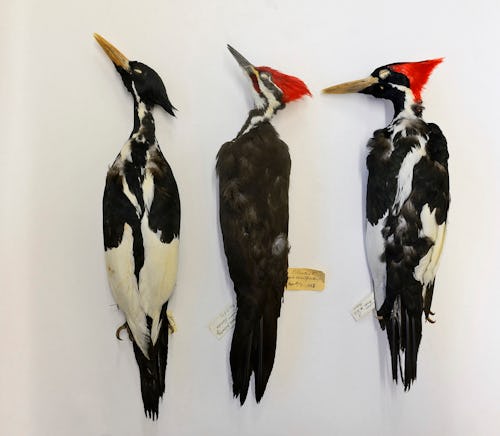Researchers claim to have sighted a bird not seen since 1944
The ivory-billed woodpecker is supposed to be extinct. Scientist Steve Latta disagrees.

If you ask the U.S. Fish and Wildlife Service, the ivory-billed woodpecker is extinct. It’s been more than half a century since anyone has seen the iconic animal, which was last officially spotted in 1944. Extensive searches through the swamplands and forests of the southern U.S. that it was once known to occupy have come up empty, which led to the declaration that the bird was gone forever.
Not so fast. Despite being labeled as extinct, researchers from the National Aviary claim to have documented physical evidence that the bird is still alive in Louisiana. In a pre-print research paper that has not yet been peer-reviewed, lead author Steve Latta and a number of other researchers lay out the evidence that while the ivory-billed woodpecker may be reclusive, it has not been wiped out entirely.
The paper, which includes a number of photos from remote cameras and drones that purport to show the woodpecker alive and well, is the result of three years of extensive searching. Researchers trekked their way through the wet woodlands of Louisiana, set up trail cameras, and kept their eyes on the region with drones. All of this was done in hopes of just getting a glimpse of the bird and document it for the first time since World War II.
The mission appears to have been a success. More than a dozen photos, along with videos and audio clips that were submitted with the research paper, appear to identify the woodpecker. Its distinct markings, including a unique red crest on their heads, make it difficult to mistake for any other species.
“There are a number of reasons the ivory-billed woodpecker has been difficult to find and document,” Latta, the director of conservation at the National Aviary and lead researcher on the project, tells Mic. “The bird’s habitat is bottomland forest, which is not easily accessible — it is densely forested, swampy, and difficult to traverse.” Latta notes that the birds tend to have a wide home range, covering up to 4 miles in diameter, and tend to fly above treetops, which makes them particularly difficult to spot.
They’re also a bit on the shy side — but perhaps with good reason. “They’re notably wary around people, which may be an adaptation in response to human pressures,” Latta explains, “but that wariness may be the thing that has contributed to its survival.”
“Having seen the bird myself and knowing now that the species survives, I feel an immense responsibility to protect it.”
The ivory-billed woodpecker used to be a common sighting throughout the southeast U.S., but they were pushed into smaller and smaller habitats as humans interfered with their existence. The bird became a prize for hunters who were after its beak, and much of its livable habitat has been shrunken by deforestation. By the late 19th century, the population of the bird was already dwindling. And then, in 1944, it seemingly was lost for good.
The findings from Latta and other researchers would be a welcome development, as they would confirm that the ivory-billed woodpecker has managed to survive human intervention after all these years. Still, the sightings don’t speak to the overall health of the species itself. Latta says he would “rather not speculate on the species’ current population size,” but notes that its presence at the site that he and his team staked out makes it more likely that the bird is also surviving in other sites.
“Regardless of the number of birds remaining, it is endangered,” Latta says. “We know that this species struggled for many decades and that conserving it now is paramount. Having seen the bird myself and knowing now that the species survives, I feel an immense responsibility to protect it and in turn, the diverse wildlife that rely on the habitat it occupies.”
While many people would be thrilled if the ivory-billed woodpecker has truly persisted, the research is likely to be controversial within birding and ornithology circles — something that Latta acknowledges. “The ivory-billed woodpecker is such an iconic species and the question of its survival has engendered strong opinions and emotions from people who have had sightings of the bird themselves to those who firmly believe it is extinct,” he explains.
Latta says he and his team are prepared for some skepticism, but believe that their data and documentation will ultimately prove that the bird is still alive. “We’ve been very encouraged by the discussions we’re having with our colleagues who have expressed interest in our evidence and find merit in the data we present,” he said. “We are confident that this interest will result in more opportunities to conserve this iconic species and its unique habitat.”
If Latta’s research is verified, it speaks to the resilience of the ivory-billed woodpecker and the ability of species to survive despite how humans interact with them. If we want to ensure that other animals stay off the extinct list, we need to reconsider our actions, and actively help them survive rather than finding them surviving in spite of us.